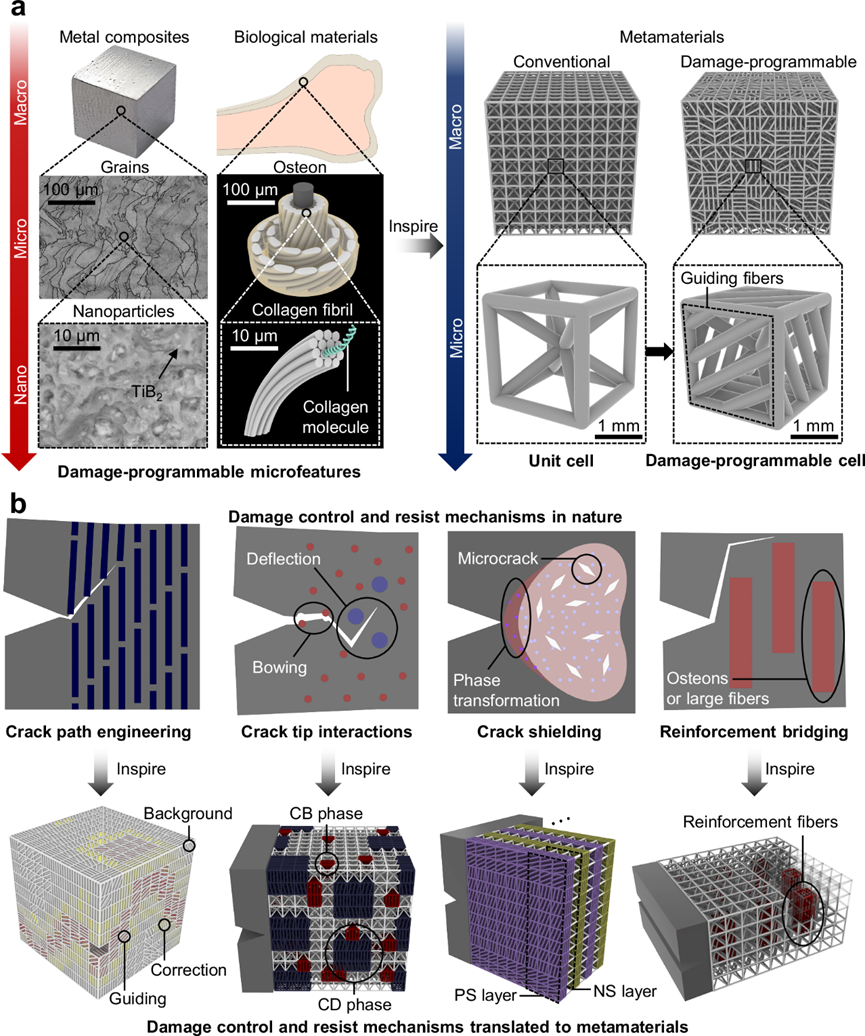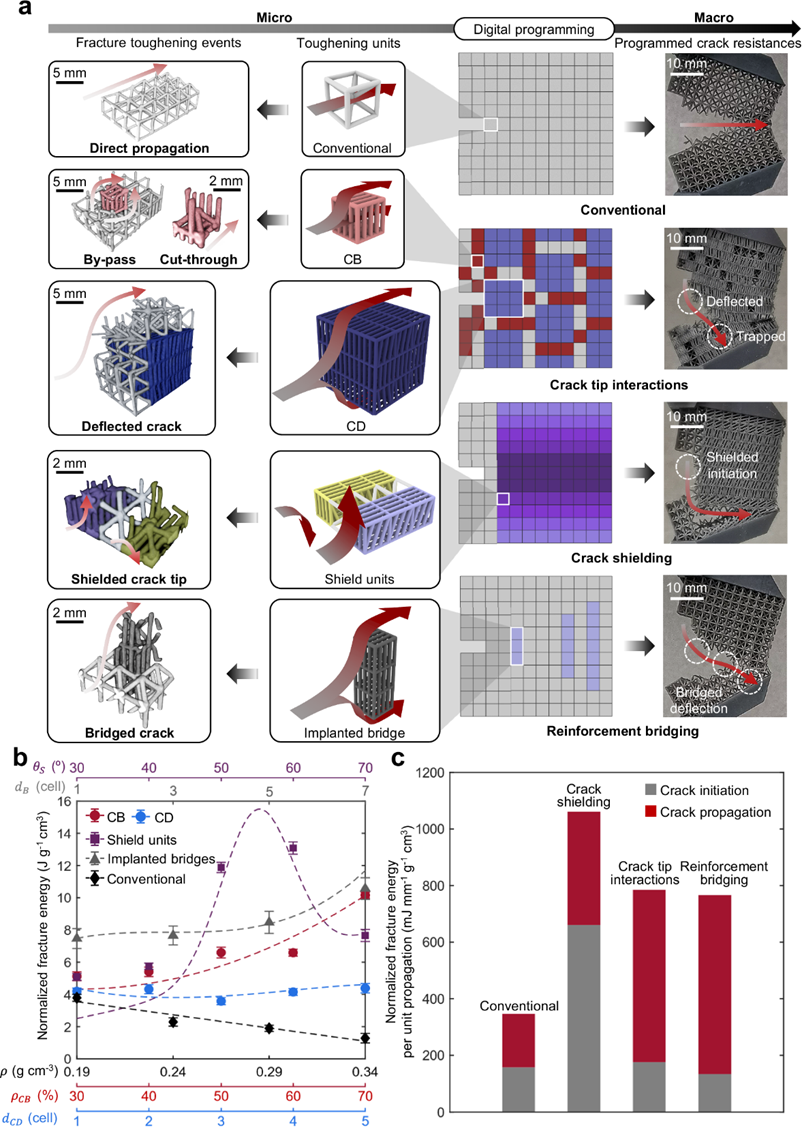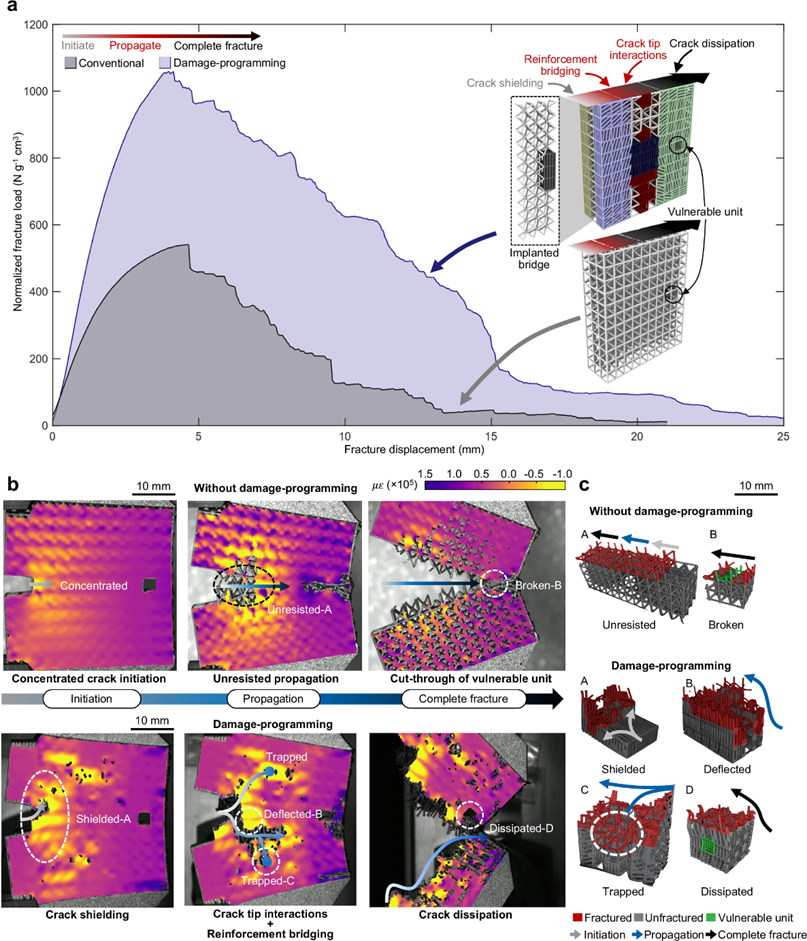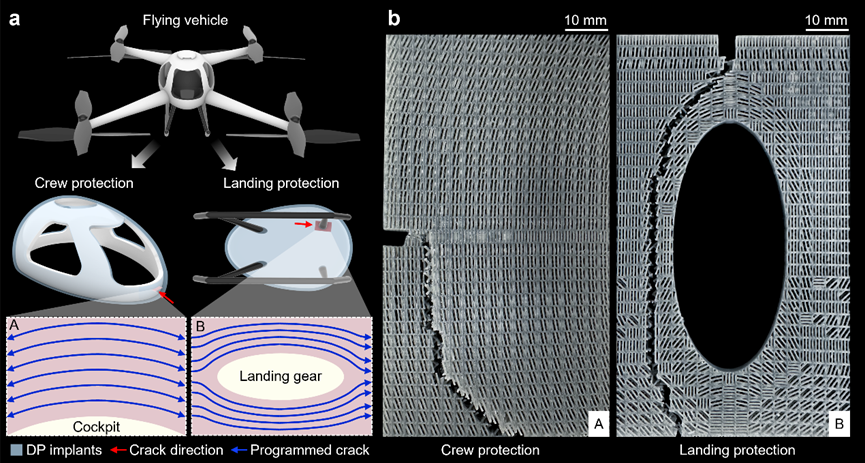Recently, Professor Haowei Wang's research group from the School of Materials Science and Engineering at Shanghai Jiao Tong University made a significant breakthrough in the field of additive manufactured meta-structures. Their findings were published in the internationally renowned academic journal Nature Communications with a paper titled “Damage-programmable design of metamaterials achieving crack-resisting mechanisms seen in nature” (doi.org/10.1038/s41467-024-51757-0). This work was jointly completed with Professor Minh-Son Pham from Imperial College London and Professor Yang Lu from the University of Hong Kong.
The research team, utilizing artificial intelligence, invented a novel metamaterial cell with programmable crack resistance. This not only enabled extraordinary programmable spatial control over three-dimensional damages but also, for the first time, translated multiple crack-resisting mechanisms from nature into 3D-printed metamaterials. The highly programmable damage design and multiple crack-resisting mechanisms significantly enhance the ability to predict and prevent fractures in engineering materials. This research also provides a new approach for studying the fracture mechanics of complex materials and structures based on metamaterial crack programming.
The paper identifies Shanghai Jiao Tong University as the first contributing institution. The first author is Zhenyang Gao, a Ph.D. student from the School of Materials Science and Engineering at Shanghai Jiao Tong University. The corresponding authors are Associate Professors Hongze Wang and Yi Wu, with co-authors including Ph.D. student Xiaolin Zhang from Shanghai Jiao Tong University, Professor Minh-Son Pham from Imperial College London, Professor Yang Lu from the University of Hong Kong, Associate Professor Cunjun Xia, and Chair Professor Haowei Wang from Shanghai Jiao Tong University.
The highly random and sudden nature of material fracture, along with the uncontrollable rapid propagation of cracks, has been a major challenge in fields such as mechanics, materials science, and engineering for a long time. Effectively predicting, controlling, and preventing the complex fracture behaviors of engineering materials is crucial for the long-term reliable service and safety of equipment. In nature, many materials, such as biological bones and ceramics, guide cracks through their complex microstructures and employ multiple fracture-toughening mechanisms to effectively prevent catastrophic crack propagation.
Inspired by natural fracture systems (Figure 1), the researchers proposed a damage-programmable metamaterial based on artificial intelligence. Through machine learning analysis of nearly a thousand different pre-programmed cell configurations—including various physical quantities such as fracture strength, fracture angle, and fracture energy—they established a multi-physics fracture knowledge database for metamaterials. Combining this database with data-driven approaches, they developed a programmable design platform for metamaterial fracture control. This platform enabled the three-dimensional programming of damages within the metamaterial and, for the first time, established a theoretical and design framework for multiple crack-resisting mechanisms mimicking those observed in nature (Figure 1b).

Figure 1. The damage-programmable design of metamaterial inspired by nature.

Figure 2. Programming the fracture resisting features in mechanical metamaterial.
Their work, combining the toughening theories found in nature, developed a fracture-toughening metamaterial design system that allows for programmable implementation of crack-resisting events in artificial materials (Figure 2). Their paper first programmed novel toughening mechanisms such as crack tip interaction, crack shielding, and reinforced bridging to the metamaterial, successfully observing fracture-toughening phenomena from the micro to the macro scale. This not only marks the first time that programmable design of fracture-toughening mechanisms has been achieved in metamaterials and even artificial materials, but also provides a novel method for exploring damage programming in future engineering materials research.

Figure 3. Fracture of damage-programmable metamaterials containing all key toughening mechanisms.
Based on the programmable toughening designs, the researchers effectively programmed different toughening mechanisms into various stages of crack initiation, crack propagation, and crack guidance (Figure 3). The study indicates that, in contrast to the rapid and direct crack propagation seen in existing conventional metamaterials, the damage-programmable metamaterials trigger multiple toughening and protective mechanisms, such as blunted and deflected crack initiation, crack trapping, and dissipating (Figure 3b), significantly increasing fracture energy density (Figure 3a). Compared to existing metamaterials of the same density with different topologies, the damage-programmable metamaterials exhibit more than a 12-fold increase in fracture energy density.

Figure 4. A flying vehicle equipped with damage-programmable metamaterials.
In terms of applications, damage-programmable metamaterials can drive advancements in fields such as flying vehicles and aerospace components by enabling functional fracture programming at both the macro and micro scales. For example, the programmable design of metamaterial fracture in critical areas can deflect and protect key components during impacts, making the aircraft more safe and reliable (Figure 4).
This work was supported by the National Key Research and Development Program (No. 2023YFB3712001), the first round National Natural Science Foundation of China for Ph.D. students (523B2048), and National Natural Science Foundation of China (52075327).
The Institute of Special Materials at the School of Materials Science and Engineering, Shanghai Jiao Tong University, is an integral part of the State Key Laboratory for Metal Matrix Composites, led by Professor Haowei Wang. The institute has established eight joint laboratories with internationally renowned universities and major enterprises. It focuses on the design, preparation, and forming technologies of novel special materials, supporting various major national engineering needs. These materials have been widely applied in areas such as defense equipment, aerospace, and automotive rail transit. Over the years, the institute has undertaken more than 50 key national defense projects, R&D plans, civilian aircraft pre-research, civilian space pre-research, National Natural Science Foundation projects, and international cooperation projects. It has published nearly 300 research papers in domestic and international academic journals and has been granted over 100 Chinese national invention patents. The institute has received several prestigious awards, including the First Prize of the Ministry of Education for Technological Invention, the First Prize of Shanghai Technological Invention, and the First Prize of Technological Invention from the China Nonferrous Metals Industry Association. Upholding the spirit of "innovation and service to the nation through scientific research," the institute is committed to advancing the frontiers of science and meeting the country's significant needs while striving for excellence.
